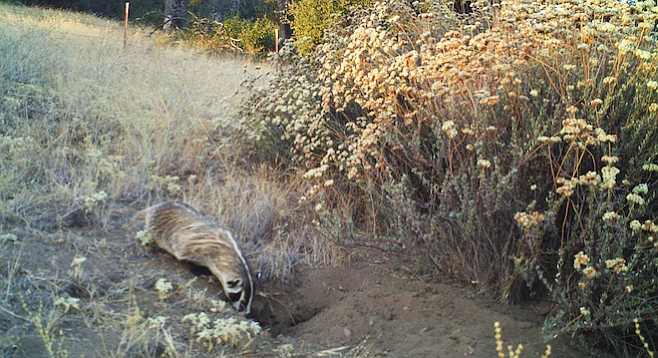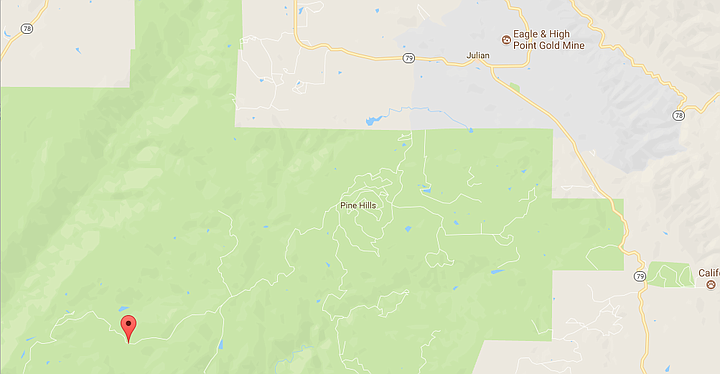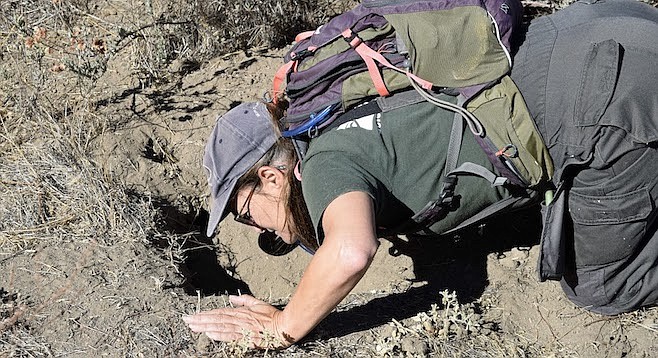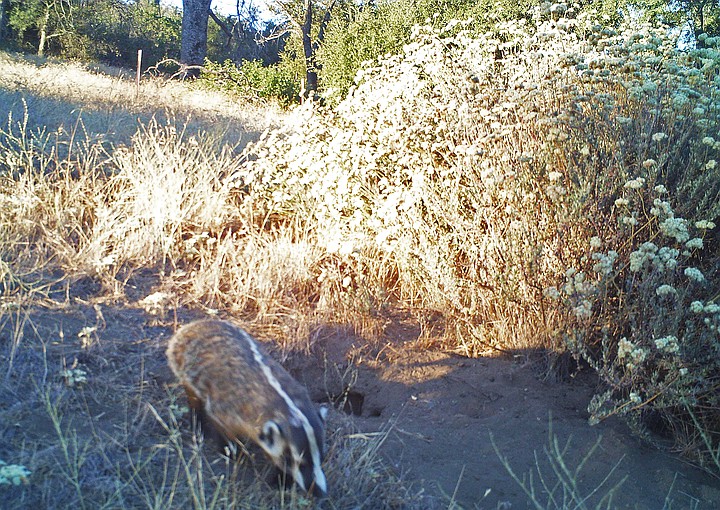 Facebook
Facebook
 X
X
 Instagram
Instagram
 TikTok
TikTok
 Youtube
Youtube

As I glance in the passenger-side rearview mirror, a dusty plume billows behind us, brightly lit by the low morning sun. Next to me in the driver’s seat, Shannon Quigley-Raymond guides her car along winding Eagle Peak Road, southwest of Julian.

As we snake along the mountain roadway, she shares how three years of conservation work have recently come to fruition. Quigley-Raymond is a river ecosystem manager with the San Diego River Park Foundation, a nonprofit organization that works to preserve and improve the resources of the San Diego River and its watershed. She explains that as part of its mission, the foundation has purchased more than 2000 acres of land in the San Diego River headwaters area. The foundation conserves and documents the wildlife and other resources at these open-space preserves.
In 2014, while surveying a newly acquired parcel of land, Shannon noticed several burrows that were quite a bit larger than the ground squirrel and gopher tunnels commonly seen. Puzzled, she took some photos and filed away a mental note of the discovery. Not long after, she attended a meeting of the San Diego Management and Monitoring Program, a group that works to coordinate and facilitate conservation in the county.

Cheryl Brehme, a biologist with the United States Geological Survey, gave a presentation about an ongoing San Diego County study of the American badger, a California “species of special concern.” When Brehme showed a photo of a badger den, Quigley-Raymond recognized it right away. After conferring with Brehme and showing her the photograph that had been taken, a trip to the site was planned.
As they approached the burrow, things looked promising. The loose, sandy soil was well covered with wild grasses, dry and swaying in the wind. Numerous small burrows betrayed the presence of the rodents that make up the diet of the American badger. When the suspect hole came into view, Brehme knew they were on to something.

Closer inspection revealed tell-tale horizontal claw marks on the wall of the tunnel, and the recent presence of a badger was confirmed.
For the next three years, Quigley-Raymond and Brehme, with the help of river-foundation volunteers, attempted to collect more evidence and data of badgers at the preserves. Metal snags were placed at burrow entrances, in the hope of harmlessly grabbing small tufts of fur for DNA analysis. Remote wildlife cameras were set, only to have two disappear and another rendered useless after being used for BB gun target practice. The researchers continued their work.
In June of this year, a new set of burrows was found and again a wildlife camera was set in place. After about a month, the memory card was retrieved, and Quigley-Raymond went through the laborious task of reviewing the 5000 or so images. With a shutter that fires when activated by a motion sensor, a windy day on a grassy meadow can mean hundreds of photos of not much more than a hole in the ground. But in one of those shots, the corner of the frame contained what looked suspiciously, but not conclusively, like a badger.
The next month was a similar story. Three images taken in very low light showed something moving toward the burrow, but again, a badger could not be confirmed.

In August the camera was repositioned to within just a few feet of the burrow under surveillance. This time, the empty hole became pay dirt. As Quigley-Raymond again flipped through thousands of images, she suddenly froze. “Badger! Badger!” she yelled, hardly able to contain her excitement. The foundation headquarters was nearly deserted on that Saturday morning, but from his office down the hall, foundation CEO Rob Hutsel rushed to join her at the computer. Together, they went through more than 30 photographs that clearly showed an American badger at the burrow.
A few minutes after she finishes recounting the saga, Quigley-Raymond pulls to the side of the road and the Subaru behind us follows suit. Inside are Katie and Eric Hengesbaugh, two river-foundation volunteers. They’ve come along to learn the location and operation of the camera so they can help with the monitoring. Not long after, we’re joined by an SUV with government plates. Brehme and Devin Adsit-Morris, a fellow biologist from the U.S. Geological Survey, grab their packs for the short hike to the den.
After negotiating our way through a barbed-wire fence, we enter the preserve. Within a few minutes, we see a steel fence post with the wildlife camera strapped to it, facing a hole nearly a foot in diameter. Loose soil, scattered by the badger while digging the burrow, litters the perimeter of the entrance. Brehme approaches the hole, leans in close, and visibly takes a deep whiff. “You can smell them if they’re in there,” she says to no one in particular.
Satisfied that the den is currently unoccupied, the team turns their attention to the camera. The memory card is inserted into the laptop Quigley-Raymond had brought along and the images saved. After reloading the camera and affixing it to its stake, the team returns to their vehicles, anxious for the analysis of the new images.
Along the way, plans to return and continue the monitoring are discussed. Once back to the road, the team separates. Brehme and Devin are headed to their next task, and the river-foundation group has another camera nearby to check. They’re hoping for pictures of a mountain lion on that one.


As I glance in the passenger-side rearview mirror, a dusty plume billows behind us, brightly lit by the low morning sun. Next to me in the driver’s seat, Shannon Quigley-Raymond guides her car along winding Eagle Peak Road, southwest of Julian.

As we snake along the mountain roadway, she shares how three years of conservation work have recently come to fruition. Quigley-Raymond is a river ecosystem manager with the San Diego River Park Foundation, a nonprofit organization that works to preserve and improve the resources of the San Diego River and its watershed. She explains that as part of its mission, the foundation has purchased more than 2000 acres of land in the San Diego River headwaters area. The foundation conserves and documents the wildlife and other resources at these open-space preserves.
In 2014, while surveying a newly acquired parcel of land, Shannon noticed several burrows that were quite a bit larger than the ground squirrel and gopher tunnels commonly seen. Puzzled, she took some photos and filed away a mental note of the discovery. Not long after, she attended a meeting of the San Diego Management and Monitoring Program, a group that works to coordinate and facilitate conservation in the county.

Cheryl Brehme, a biologist with the United States Geological Survey, gave a presentation about an ongoing San Diego County study of the American badger, a California “species of special concern.” When Brehme showed a photo of a badger den, Quigley-Raymond recognized it right away. After conferring with Brehme and showing her the photograph that had been taken, a trip to the site was planned.
As they approached the burrow, things looked promising. The loose, sandy soil was well covered with wild grasses, dry and swaying in the wind. Numerous small burrows betrayed the presence of the rodents that make up the diet of the American badger. When the suspect hole came into view, Brehme knew they were on to something.

Closer inspection revealed tell-tale horizontal claw marks on the wall of the tunnel, and the recent presence of a badger was confirmed.
For the next three years, Quigley-Raymond and Brehme, with the help of river-foundation volunteers, attempted to collect more evidence and data of badgers at the preserves. Metal snags were placed at burrow entrances, in the hope of harmlessly grabbing small tufts of fur for DNA analysis. Remote wildlife cameras were set, only to have two disappear and another rendered useless after being used for BB gun target practice. The researchers continued their work.
In June of this year, a new set of burrows was found and again a wildlife camera was set in place. After about a month, the memory card was retrieved, and Quigley-Raymond went through the laborious task of reviewing the 5000 or so images. With a shutter that fires when activated by a motion sensor, a windy day on a grassy meadow can mean hundreds of photos of not much more than a hole in the ground. But in one of those shots, the corner of the frame contained what looked suspiciously, but not conclusively, like a badger.
The next month was a similar story. Three images taken in very low light showed something moving toward the burrow, but again, a badger could not be confirmed.

In August the camera was repositioned to within just a few feet of the burrow under surveillance. This time, the empty hole became pay dirt. As Quigley-Raymond again flipped through thousands of images, she suddenly froze. “Badger! Badger!” she yelled, hardly able to contain her excitement. The foundation headquarters was nearly deserted on that Saturday morning, but from his office down the hall, foundation CEO Rob Hutsel rushed to join her at the computer. Together, they went through more than 30 photographs that clearly showed an American badger at the burrow.
A few minutes after she finishes recounting the saga, Quigley-Raymond pulls to the side of the road and the Subaru behind us follows suit. Inside are Katie and Eric Hengesbaugh, two river-foundation volunteers. They’ve come along to learn the location and operation of the camera so they can help with the monitoring. Not long after, we’re joined by an SUV with government plates. Brehme and Devin Adsit-Morris, a fellow biologist from the U.S. Geological Survey, grab their packs for the short hike to the den.
After negotiating our way through a barbed-wire fence, we enter the preserve. Within a few minutes, we see a steel fence post with the wildlife camera strapped to it, facing a hole nearly a foot in diameter. Loose soil, scattered by the badger while digging the burrow, litters the perimeter of the entrance. Brehme approaches the hole, leans in close, and visibly takes a deep whiff. “You can smell them if they’re in there,” she says to no one in particular.
Satisfied that the den is currently unoccupied, the team turns their attention to the camera. The memory card is inserted into the laptop Quigley-Raymond had brought along and the images saved. After reloading the camera and affixing it to its stake, the team returns to their vehicles, anxious for the analysis of the new images.
Along the way, plans to return and continue the monitoring are discussed. Once back to the road, the team separates. Brehme and Devin are headed to their next task, and the river-foundation group has another camera nearby to check. They’re hoping for pictures of a mountain lion on that one.
Comments